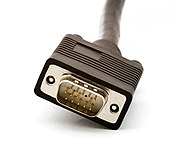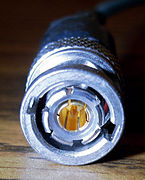Gender of connectors and fasteners: Difference between revisions
m Added links to plug and jack Wiki pages. |
removed unsourced, untrue, & offensive nonsense |
||
| Line 18: | Line 18: | ||
*FIP denotes Female International Pipe thread. |
*FIP denotes Female International Pipe thread. |
||
A |
A short length of pipe having an MIP at both ends is sometimes called a "nipple".<ref>[http://www.plumbingsupply.com/chrome.html Chrome Fittings & Nipples]</ref> |
||
===Electrical and electronic connectors=== |
===Electrical and electronic connectors=== |
||
| Line 71: | Line 71: | ||
}} |
}} |
||
Devices used for mating two connectors of the same gender have a wide variety of terms, including for example: "[[gender changer]]", "gender mender", "gender bender", "gender blender", "sex changer", and the somewhat officious sounding "homosexual adapter".<ref>[http://catb.org/jargon/html/G/gender-mender.html Jargon File: gender mender]</ref> A specific gender changer can be referred to by either the gender of its connectors, or the gender for which it is designed to connect to. Thus a "male gender changer" might have female connectors to mate two male ends, or male connectors to mate two female ends. |
Devices used for mating two connectors of the same gender have a wide variety of terms, including for example: "[[gender changer]]", "gender mender", "gender bender", "gender blender", "sex changer", and the somewhat officious sounding "homosexual adapter".<ref>[http://catb.org/jargon/html/G/gender-mender.html Jargon File: gender mender]</ref> A specific gender changer can be referred to by either the gender of its connectors, or the gender for which it is designed to connect to. Thus a "male gender changer" might have female connectors to mate two male ends, or male connectors to mate two female ends. |
||
==Signal or power taps== |
==Signal or power taps== |
||
Revision as of 06:06, 28 July 2010
This article needs additional citations for verification. (September 2009) |

In electrical and mechanical trades and manufacturing, each of a pair of mating connectors or fasteners is conventionally assigned the designation male or female. The "female" connector is generally a receptacle that connects to and holds the "male" connector.
The assignment is by direct analogy with genitalia and sexual intercourse; the part bearing one or more protrusions, or which fits inside the other, being designated male and the part containing the corresponding indentations or fitting outside the other being female. Extension of the analogy results in the verb to mate being used to describe connecting two ends together.
Definitions
The standard letters "M" and "F" are commonly used in part numbers to designate gender. For example, in Switchcraft XLR microphone or hydrophone connectors, the part numbers are denoted as follows:
- A3F = Audio 3-pin Female connector;
- A3M = Audio 3-pin Male connector.
The terms "slot," "socket," and "receptacle" are also often used for "female" connectors, and "Plug," "prong," and "pin" for "male" connectors. In many cases these terms are more common than male and female, especially in documentation intended for the non-specialist. It also causes a fair amount of confusion when those names are shortened in labels. For example, a female high-density D-subminiature connector with a size 1 shell can be named DE15F or DE15S (see accompanying pictures). Both terms mean the same thing but could be confused for different items. Similarly, a male standard-density D-sub with a size 1 shell can be named DE9M or DE9P; a female standard-density D-sub with a size 2 shell can be named DA15F or DA15S; a male high-density D-sub with a size 3 shell can be named DB44M or DB44P; and so forth. Further confusion can be caused by the term jack, which is used for both female and male connectors and typically refers to the fixed (panel) side of a connector pair.
Plumbing connectors
In plumbing fittings, the "M" or "F" usually comes at the beginning rather than the end. For example:
- MIP denotes Male International Pipe thread;
- FIP denotes Female International Pipe thread.
A short length of pipe having an MIP at both ends is sometimes called a "nipple".[1]
Electrical and electronic connectors
Although the gender of tubing and plumbing fittings is usually obvious, this is not true of electrical connectors because of their more complex and varying constructions. Instead, connector gender is conventionalized and thus can be somewhat obscure to the uninitiated. For example, the female D-subminiature connector extends outward from the body, and this protrusion could be erroneously construed as male. Instead, the masculinity of the D-subminiature connectors is defined by specific presence of pins, rather than by the protrusion of the connector, which is also true for many other pin-based connectors like XLR. The male/female distinction is more obvious with ring connectors which are placed around a post, but again with spade or split ring connectors the end alone is not obviously female. Finally, some connectors are hermaphroditic and include both male and female elements in a single unit, such as the IBM token ring connector and the SAE connector; hermaphroditic connections also exist in some specialized tubing fittings. IEEE STD 100 and ANSI Y32.16 (identical to IEEE 200-1975 and replaced by ASME Y14.44-2008) define "Plug" and "Jack" by location or motion, rather than gender[2][3]. A connector in a fixed location is a jack, and a moveable connector is a plug. The distinction is relative, so a portable radio is considered stationary compared to the cable from the headphones; the radio has a jack, and the headphone cable has a plug. Where the relationship is equal, such as when two flexible cables are connected, each is considered a plug and annotated with the P reference designator. It is common practice to use female connectors for jacks, so the informal gender-based usage often agrees with the functional description of the technical standards. This is not always the case; Exceptions include a computer's AC Power Inlet and EIA232 DE9 Serial Port. It is best to use "male" and "female" for gender, and "Plug" and "jack" for function.
Male connector pins are often protected by a shell, which envelops the entire female connector. RF connectors often have multiple layers of interlocking shells to properly connect coaxial and triaxial cable. In such cases, the gender is assigned based on the innermost connecting point.
-
A female VGA connector which serves as a jack.
-
A male DE-9 serial port connector which serves as a jack.
-
A serial cable with a female connector on each end, both of which serve as a plug.
-
A male VGA connector which serves as a plug. The pins make this male; the surrounding shield does not change that.
-
Male 50 ohm BNC connector plug. Three circular projections (including the central pin) interlock with two rings of the female.
-
Triaxial BNC connector, another male plug
Safety


In electrical connections where voltage is sufficient to cause injury, the part connected to the power source is invariably female, to prevent inadvertent contact. A male plug is on the cord of (or on) the device drawing the power.
In low-voltage use, such as for data communications, this is less important, and male or female connectors are used based on other engineering factors such as convenience of use or ease of manufacturing. For example, the common "patch cables" used for Ethernet (and the similar cords used for telephones) typically have modular plugs on both ends, to connect to sockets on equipment or mounted in walls.
The gender of a connector is determined by the structure of its primary functional components — i.e., the conductors of an electrical connector, or the load-bearing parts of a fastener — and not by secondary features such as covers, shields or handles that may be installed for environmental protection, safe operation, etc.
Genderless connectors
Certain connector designs (such as the SAE connector, and jackhammer air hose connectors) involve paired identical parts each containing both protrusions and indentations. The term hermaphrodite (or hermaphroditic) is used for such devices, along with genderless, combination (and combo), two-in-one, two-way, and others.
Some audio multicore cables are fitted with hermaphroditic multipin quick-disconnect connectors for ease of use in the field. One style of this audio signal cable is fitted on both ends with connectors that are each populated half with pins and half with sockets.[4] The advantage to the user is that it doesn't matter which end connects to the stage and which to the audio mixer, facilitating faster set up times.[5] Another style of connector uses hybrid male/female pins with a receiving slot fitted in the center of each two-tine pin, and relies on 90-degree rotation of the pin axes to mate. The connector housings themselves are sexed male and female.[6]
-
Hermaphroditic or genderless hose connectors.
-
IBM hermaphroditic connector with locking clip.
-
4-conductor hermaphrodite connector for token ring attachment.
-
Detail of mating surfaces of hermaphrodite connector.
Gender changer
-
DA15 and DB25 D-subminiature gender changers.
-
A female to female BNC connector.
Devices used for mating two connectors of the same gender have a wide variety of terms, including for example: "gender changer", "gender mender", "gender bender", "gender blender", "sex changer", and the somewhat officious sounding "homosexual adapter".[7] A specific gender changer can be referred to by either the gender of its connectors, or the gender for which it is designed to connect to. Thus a "male gender changer" might have female connectors to mate two male ends, or male connectors to mate two female ends.
Signal or power taps
Some connectors have both male and female connectors on opposite sides, designed to be placed between a male and female to intercept a signal or to take power. These may also be referred to as hermaphrodite connectors, or alternately vampire or parasite plugs.[citation needed] These were once used for PC accessories, placed between the output of an AT power supply and a monitor so these accessories would be disconnected from power when the computer was switched off, but are now impractical with the dominance of ATX supplies which lack a mains output socket.
Examples

- A power cord on an appliance terminates in a (male) plug; it connects to a (female) socket in a wall or on an extension cord.
- Co-axial cables used for video or other high-frequency signals are normally terminated, at both ends, in a connector comprising an inner pin and an outer fixed or rotating shell; these are conventionally reckoned as male.
- A nut is female and a bolt is male.
- Connectors for air brake hoses on heavy trucks and railroad equipment use genderless "gladhand" connectors. In railroad air brake use, this makes the orientation of rolling stock irrelevant, and is used with the standard North American railroad coupler that connects cars together, also genderless.
- Piping and plumbing fittings
- The Talmud (c. 500 CE) describes arrow heads and mating shafts as being male and female, i.e. a prong on a male arrow head fits into a hollowed out shaft and vice versa. [8]
References
- ^ Chrome Fittings & Nipples
- ^ Standard Reference Designations for Electrical and Electronics Parts and Equipments: IEEE-200-1975 (Reaffirmed 1988): Section 4.1.5.3. IEEE and ANSI, New York, NY. 1975.
- ^ Reference Designations for Electrical and Electronics Parts and Equipment: ASME Y14.44-2008 : Section 2.1.5.3 (2). ASME, Fairfield, NJ. 2008.
- ^ Whirlwind Technical Articles. Wiring MASS Connectors FAQ
- ^ Live Sound International. Archives, April 2003. Connect Corner: The ins and outs of multipin connector designs. Peter Janis, Cabletek.
- ^ EDAC. 516 Series Plug & Receptacle Rack & Panel Connectors with EDACON Hermaphroditic Contact Mating Design.
- ^ Jargon File: gender mender
- ^ Goldwurm, R. Hersh, Ed. Talmud Bavli: Tractate Sucah I, Schottenstein Edition. Brooklyn, NY: Mesorah Publications Ltd.
{{cite book}}: Cite has empty unknown parameter:|coauthors=(help)CS1 maint: multiple names: authors list (link)Gemara p.12a1












